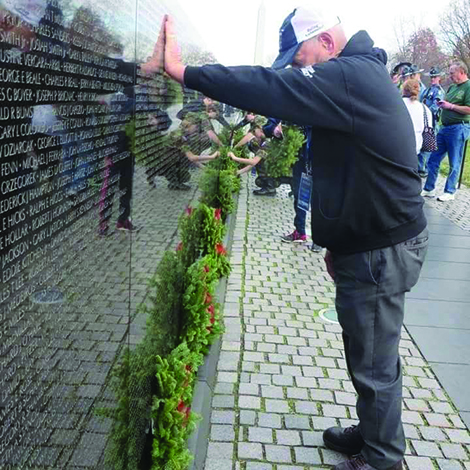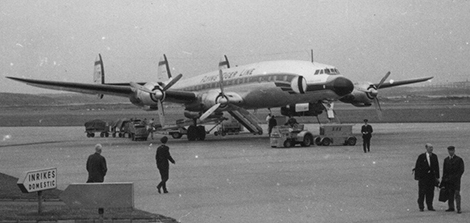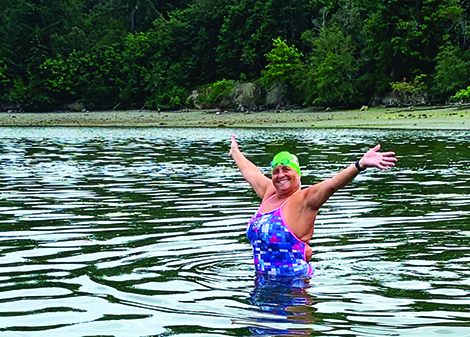Flying Tiger Flight 739: ‘Honor their service’


On March 16, 1962, Flying Tiger Line Flight 739 was part of a secret mission sanctioned by President John F. Kennedy when it went missing on a cross-Pacific flight to Vietnam. No trace of the plane or its 104 American passengers–93 Army soldiers, including seven from Washington, and 11 civilian crew members–has ever been found.
Little is known for certain about what happened to Flight 739, and due to the circumstances surrounding the mission, the names of those lost haven’t been added to the Vietnam Veterans Memorial in Washington, D.C., despite their apparent connection to the Vietnam War. Many families are fighting to have their loved ones recognized. So far, the only monument that bears their names was erected by a private citizen, Morrill Worcester, in Columbia Falls, Maine, where a 60th anniversary commemoration of the losses was held March 16.
“When I first heard the story about this mission, I was shocked that nothing has been done for the families. I said that day that we would do something to make sure these people are honored and remembered, and to hopefully give some closure to these families,” said Worcester, who founded the non-profit Wreaths Across America in 1992 to expand and coordinate wreath-laying ceremonies throughout the U.S. as one of its ways of honoring military members who died in the line of duty.
Among the soldiers who perished in Flight 739 were five from Pierce County– Albert Francis Williams Jr., Wallace L. Walcott, Edison L. Roberts, and Walter Glynn, all of Tacoma, and James C. Sorenson of Spanaway. The others from Washington were Timothy F. Hopkins of Spokane and Howard Gallipeau Jr. of Alderwood Manor in Snohomish County.
Their military ranks ranged from specialist to master sergeant.
Spokesman Sean Sullivan said Wreaths Across America has been “looking to connect” with their relatives, but with little success. Williams’ family is the only one that has been in touch, he said. Sullivan gave Senior Scene contact information for a son and a daughter of Williams, but they couldn’t be reached for comment.
Flight 739 was a Lockheed L-1049 Super Constellation propliner chartered from Flying Tiger by the U.S. military for the flight from Travis Air Force Base in California to Saigon. After refueling in Guam and resuming its flight, the plane disappeared. Searches for eight days by aircraft and Navy ships found nothing. Reports of a possible in-flight explosion couldn’t be confirmed, leaving possible causes of the demise of the lives and airplane shrouded in mystery ever since.
Flying Magazine, in an article in March recalling the events of 60 years ago, noted the U.S. was quietly increasing its presence in the Vietnam War by sending equipment and advisers, such as those on Flight 739 (which also carried three Vietnamese military members), to support the government of the then-Republic of Vietnam against the Viet Cong. The magazine said the U.S. soldiers on the plane specialized in electronics, communications, and sharpshooting.
The private memorial in Maine that is inscribed with the names of Flight 739’s lost military lives is the only formal public recognition of their sacrifice, but Congress could change that. U.S. Sen. Gary Peters of Michigan is the sponsor of Senate Bill 2571, which seeks to have their names added to the national Vietnam War Memorial in D.C.
Sen. Maria Cantwell of Washington is on a Senate committee that is reviewing the proposed legislation.
The memorial “wall,” as it’s also known, currently has 58,318 names of those “who made the ultimate sacrifice during the war,” said Joe Reagan, director of military and veteran outreach for Wreaths Across America. The number needs to increase, he said.
Reagan, citing his experience as an Army veteran who served alongside the American military’s special operations and intelligence communities, said he knows “we may never have the opportunity to share the full story” of what happened to the Flight 739 victims. “This shouldn’t stop us from providing their families and all Americans the opportunity to honor their service by saying their names in our nation’s capital,” he said.


